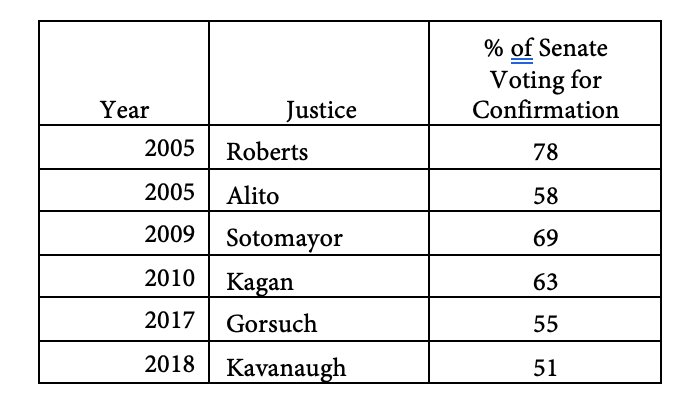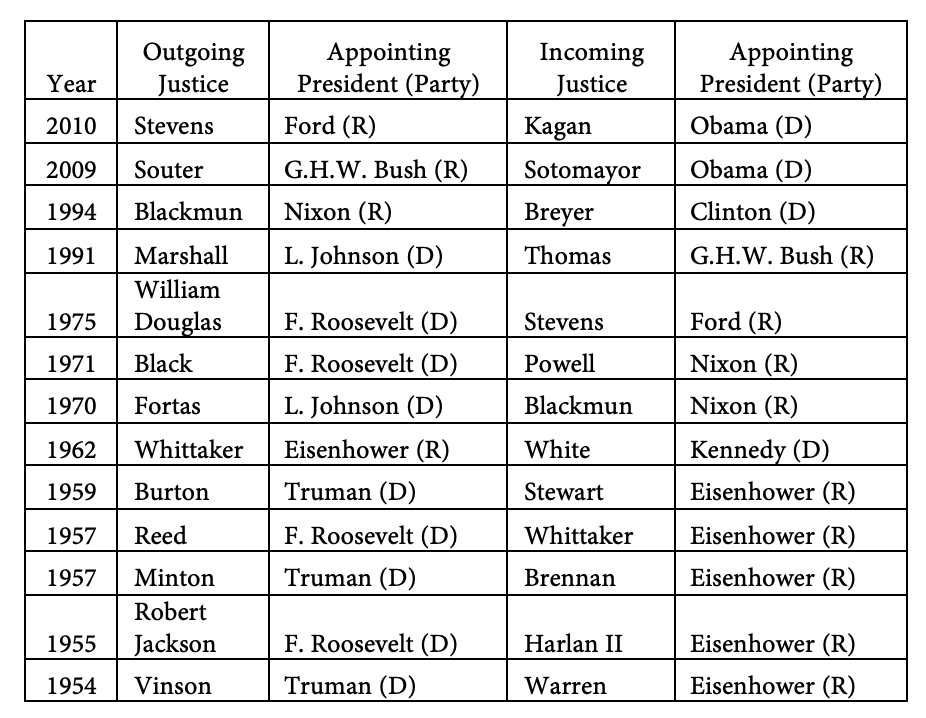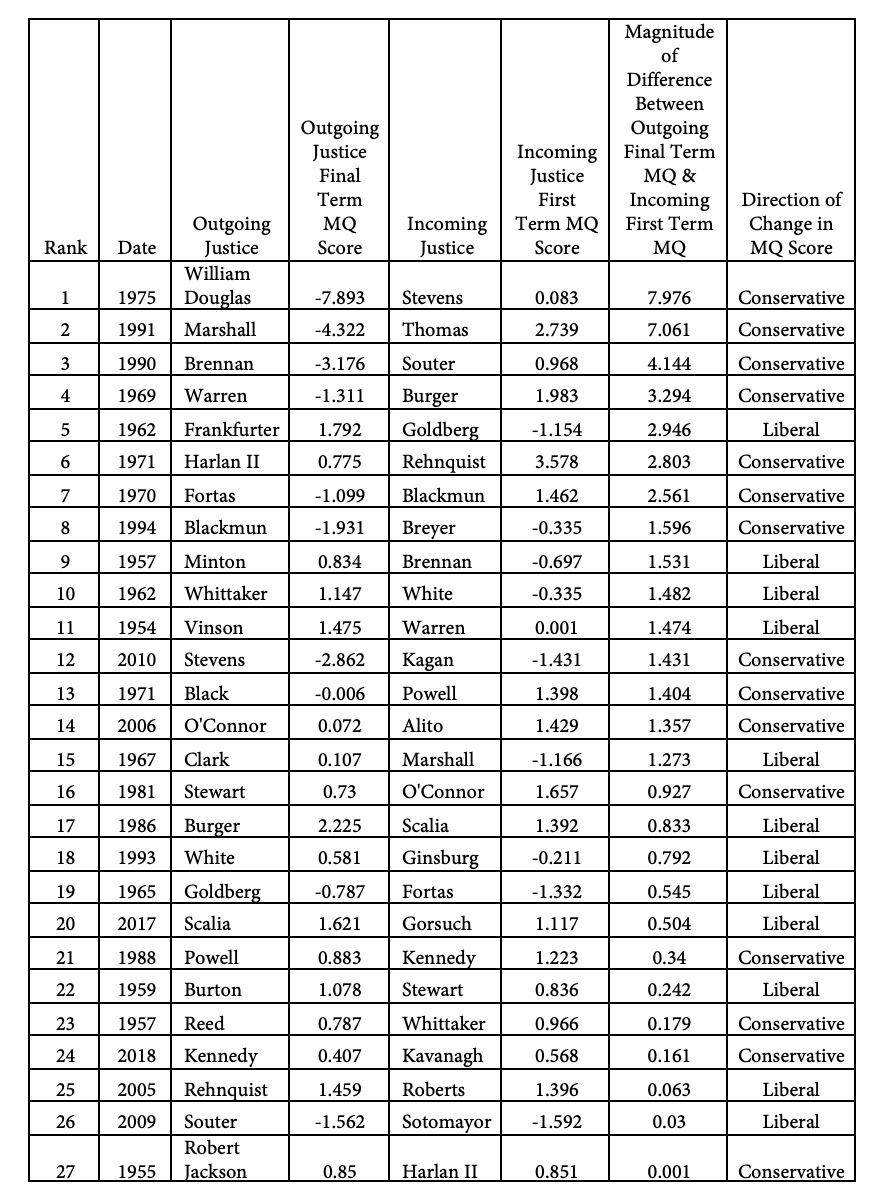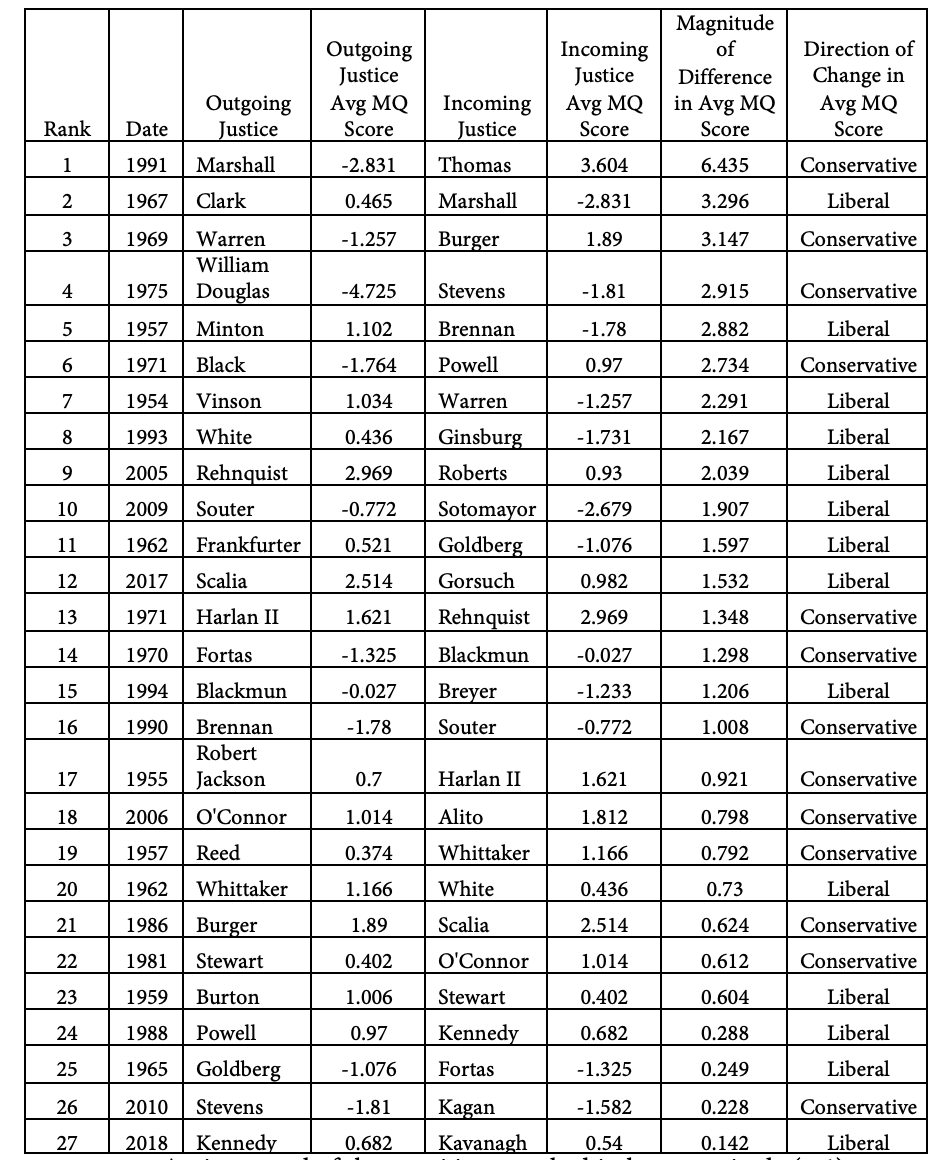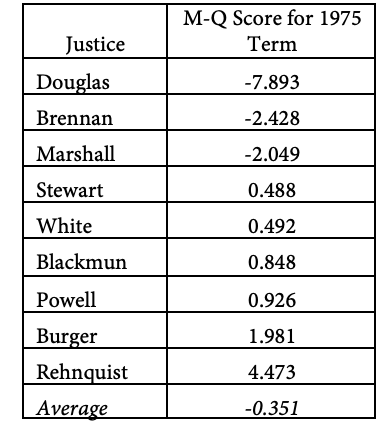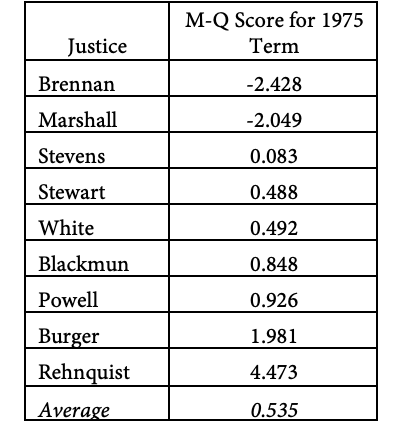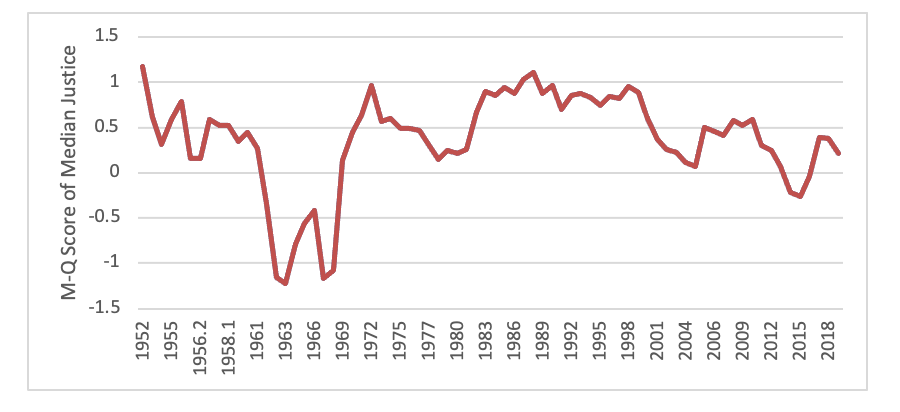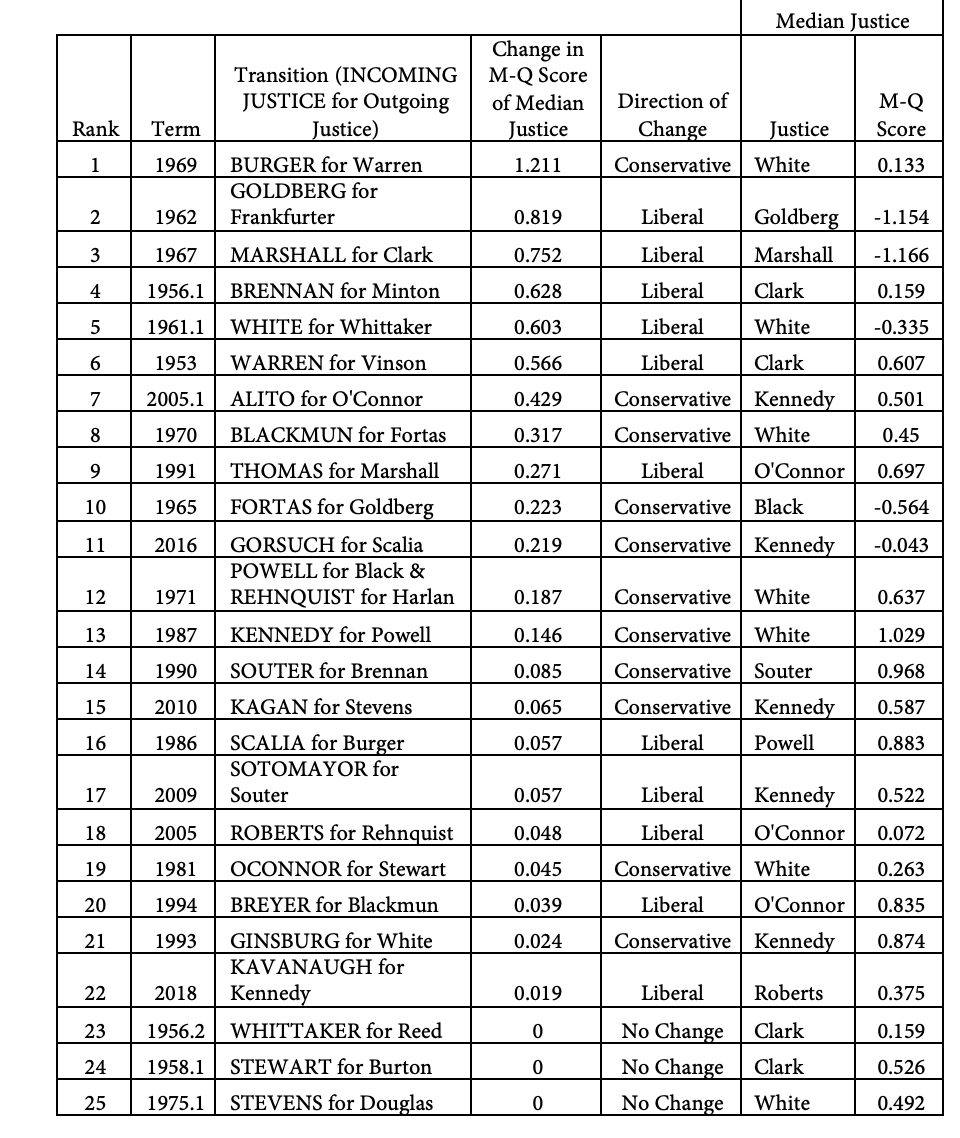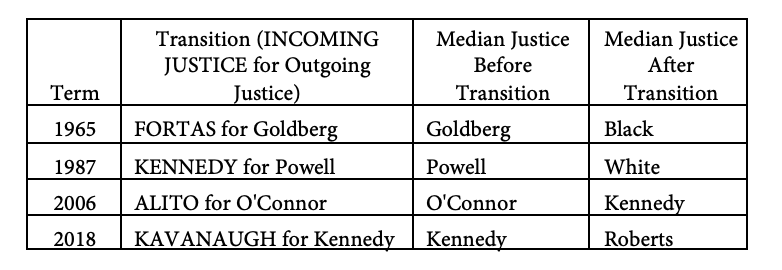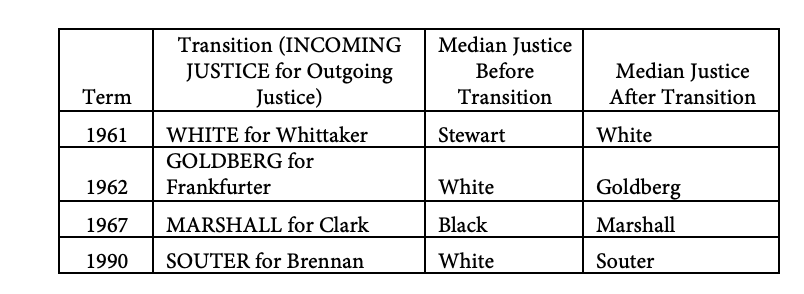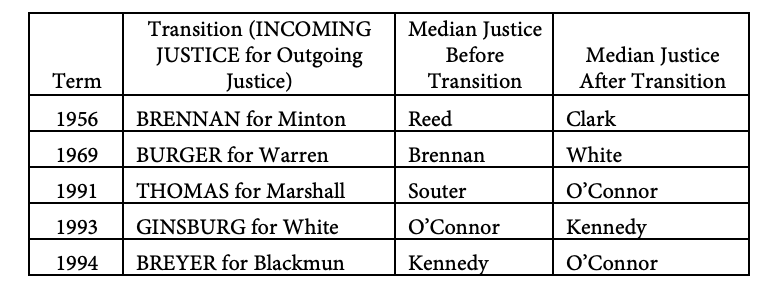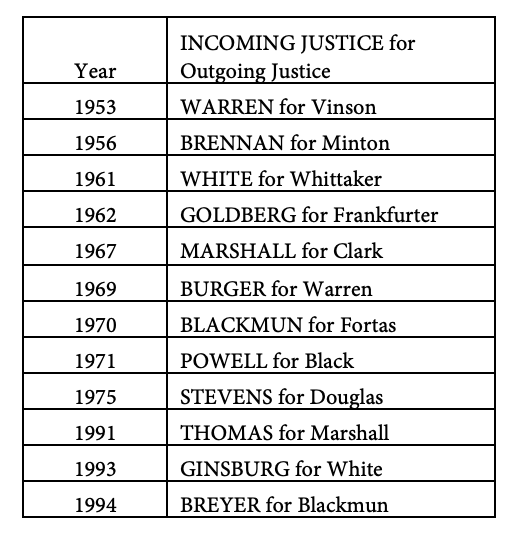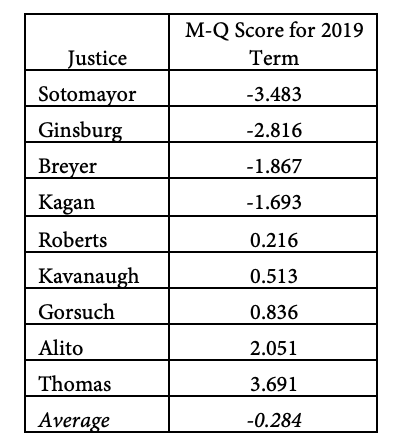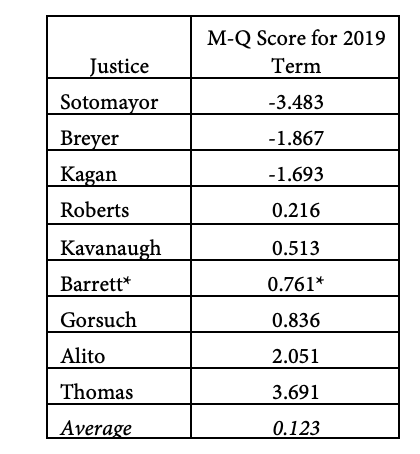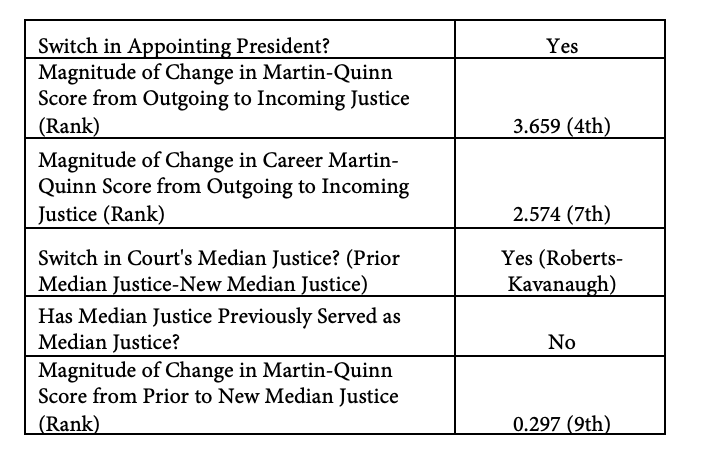Introduction
Lightning struck on September 18, 2020. In a year in which so many unimaginable events had unfolded and were unfolding, the death of Justice Ruth Bader Ginsburg sent shock waves not only through the nation’s legal community, but throughout the country. Ginsburg, a champion of women’s rights as both lawyer and Justice, the multi-time survivor of cancer, the Court’s tiny, surprising, and notorious rock star, passed away at a precarious moment. Aside from the existential challenge presented by the COVID-19 pandemic, the nation was 46 days from a presidential election. Given that the responsibility of nominating Supreme Court Justices fell to the President, battle lines were drawn over whether the current President ought to move forward nominating a replacement for Justice Ginsburg, or rather, whether the results of the election should impact who the next Justice would be.
Of course, similar lines had been drawn another time lightning had struck in a year of a presidential election, although the individuals guarding the lines had been reversed. In February 2016, Ginsburg’s friend, colleague, and rock star in his own way, Antonin Scalia, had passed away nearly nine months before the presidential election. Republican Senators mobilized to resist allowing Barack Obama to nominate Justice Scalia’s replacement, though many of the same Senators pushed forward in fall 2020 to replace Justice Ginsburg.
During the 2016 kerfuffle, Ginsburg had candidly revealed her own thoughts on the matter. “There’s nothing in the Constitution that says the president stops being president in his last year,” she said before offering an endorsement of Obama’s nominee Merrick Garland as “[s]uper bright and very nice” and “about as well qualified as any nominee to this court.”1 So long as the Senate delayed, however, the identity of her next colleague on the Court would depend on the outcome of the election. At the prospect of a Donald Trump presidency, Ginsburg joked that her deceased husband would have said, “Now it’s time for us to move to New Zealand.”2 While Ginsburg ultimately apologized for her public criticism of a candidate for public office,3 she had made clear her opinion about the impact Trump could have: “For the country, it could be four years. For the Court, it could be—I don’t even want to contemplate that.”4
Four years later, with Trump completing a term in the White House in which two Supreme Court nominees (not to mention many other federal judges) had already been confirmed and seated, Ginsburg was forced to contemplate it in an unimaginable way. Just days before her death, she dictated a statement to her granddaughter: “My most fervent wish is that I will not be replaced until a new president is installed.”5
Justice Ginsburg’s passing elevated the Supreme Court to the top of public dialogue on the election in the days that followed. The prospect of Trump replacing a liberal icon on the Court brought into focus the stakes of transitions among the Court’s nine Justices to the point that it was the first question asked in the first presidential debate.6 Aside from the partisan battle over proceeding with a nomination and confirmation hearings in the shadow of the election as discussed elsewhere in this volume, the replacement of Justice Ginsburg would be the latest in the most unpredictable of American constitutional events: the replacement of a Supreme Court Justice. Like a bolt of lightning, such an event could happen at any time, and while its impact would always be significant, its magnitude would depend on circumstances.
This paper seeks to contextualize modern Supreme Court transitions from 1953 to the present. First, it lays out the circumstances and variables that make Supreme Court transitions so unpredictable and potentially impactful. Then, the paper identifies a series of specific characteristics that can reveal the impact of Court transitions, such as the ideological balance of the Court and the ideological leanings of the sitting President, as well as the departing and incoming Justices. Using these criteria, the paper will present data and rankings of the twenty-seven transitions between 1953 and 2018 beginning with the arrival of Chief Justice Earl Warren, a transition that marked a new era in the role of the Court within the country. Finally, the paper will contextualize the potential replacement of Justice Ginsburg using the same criteria, providing an analysis of prior Court transitions most analogous to this one. If Ginsburg is replaced by a Trump nominee confirmed by the Republican Senate, it is likely to be one of the more impactful strikes of lightning of this era.7
I. Supreme Court Transitions as Constitutionally Unique Moments
A transition among the Justices of the United States Supreme Court is a unique event in the American constitutional system. While the Constitution created a “supreme Court,” and vested the nation’s judicial power in that body, it says precious little else about the body.8 Federal judges, the document directs, “shall hold their Offices during good Behaviour, and shall, at stated Times, receive for their Services, a Compensation, which shall not be diminished during their Continuance in Office.”9
For the nation’s other constitutional actors—the President and members of Congress—the Constitution lays out details regarding qualifications for office and the means and frequency of election.10 For the Justices of the Supreme Court, there is no mention of any qualifications. The appointment process is defined not in Article III, which lays out a role for the government’s judiciary, but in Article II, defining the executive branch. Toward the end of a long list of powers of the President (ahead of only a catch all “and all other Officers” clause), the Constitution dictates the “Judges of the supreme Court” are to be appointed by the President, by and with the advice and consent of the Senate.11
And that’s it.
What we know from the Constitution about the Supreme Court is paltry: the Court exists, its judges will be appointed by the President with advice and consent from the Senate, they will serve for their lifetimes, be paid for their work, and not receive a pay cut. While the Constitution provided for some jurisdictional guidelines for the Court’s work,12 it left much of the work in defining the Court—its makeup and its authority—to Congress.13 The first Congress passed the Judiciary Act of 1789, which created the first positions on the Court, six Justices, including a Chief Justice.14 Upon signing the Judiciary Act into law, President Washington quickly performed his constitutional duty by nominating the Court’s first six Justices, each of whom was confirmed by acclamation in the Senate.15 With that, the process of filling the seats among the Justices of the Supreme Court began.
Since 1789, 114 Americans have served as justices of the Supreme Court—thus, a replacement has occurred, on average, every two to two and a half years.16 But even speaking of such regularity belies the wildly unpredictable nature of transitions on the Supreme Court. While the average might be a new appointment every other year, the reality is that the timing of Court transitions varies widely. For example, in 1811, two of James Madison’s nominees (Gabriel Duvall and Joseph Story) were confirmed to the Court on the same day (though they were seated several months apart);17 in the Court’s more contemporary period, in 1971, two of Richard Nixon’s nominees (Lewis Powell and William Rehnquist) were confirmed days apart from one another and joined the Court on the same day.18 At the other extreme, the nine Justices who served the eleven years from 1994 through 2005 did so without a single transition on the Court.19 Such variation occurs for many reasons, including historical fluctuation in how many Justices serve on the Court, but mostly due to the lifetime appointment that Justices receive. Transitions (generally) only occur when a sitting Justice retires or passes away.20 Thus, unlike the President, who is up for election every four years, or members of Congress, who face the electorate every two years in the House and every six years in the Senate, there is no timetable for Supreme Court transitions.21
There is unpredictability, too, in the identity of who might become a Supreme Court Justice at any given moment. The Constitution says nothing on the matter aside from identifying who nominates a Justice (the President) and how they are confirmed (by the Senate). As a result, every Supreme Court transition depends substantially on who sits in the White House and the political balance of power in the Senate.
A Supreme Court transition, then, depends primarily on four variables: the identity of the departing Justice, the identity of the President, the balance of power in the Senate, and the identity of the incoming Justice. And since a transition only occurs when a sitting Justice wishes it (through retirement or resignation) or when a sitting Justice passes away, as has occurred for 51 of the 106 Justices to end their tenures, the variables only matter at the lightning-strike moment that a transition occurs. Simply being President does not guarantee an appointment: in his first term, Richard Nixon made four appointments; during his four years in office, Jimmy Carter made none.22
All of this randomness and unpredictability make every Supreme Court transition important. Whenever a transition occurs, there is no way of knowing when the next one will come (or when it does, which Justice will depart or who will be President or who will control the Senate). As the Supreme Court has come to play an increasingly significant role in not only the legal, but the cultural life of the nation, the stakes have been amplified. As seen in Figure 1, whereas Washington’s first six Justices (and many others) were confirmed unanimously, the most recent six confirmations have seen Justices confirmed with between 51% (Kavanaugh, 2018) and 78% (Roberts, 2005) of support in the Senate, a run of contested confirmations unprecedented in the Court’s history.
Figure 1. Senate Confirmation Votes for Selected Justices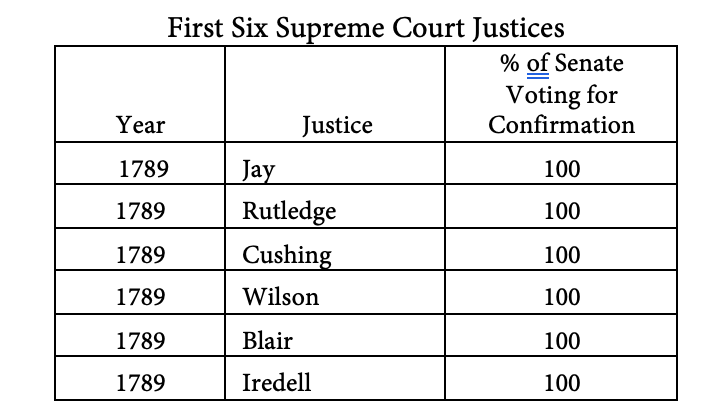
Six Most-Recently Appointed Supreme Court Justices
As the balance of the Court shifts, the variables that have always dictated Supreme Court transitions—outgoing and incoming Justice, political control of the White House and Senate—overlay yet another variable: the likely impact on the decisions the Court will make. The stakes are highest in the moments when the transition portends a fundamental shift in the balance of the Court. That possibility is highest when the departing Justice is to be replaced by a President whose ideology differs and when the Court is already closely divided. For example, when Antonin Scalia passed away in February 2016 during Barack Obama’s presidency, the prospect of a left-leaning President replacing a conservative Justice on a Court with an ideological balance of 5-4 in favor of conservatives might have flipped the Court. Of course, Republicans controlled the Senate at the time, a power they utilized to deny hearings to Obama’s nominee Merrick Garland. The transition that ultimately resulted after the election of Donald Trump—from Scalia to Neil Gorsuch—had a far less significant impact on the Court’s ideological balance than a Scalia-to-Garland transition might have and the Court’s 5-4 balance was maintained.
Thus, not all Court transitions are created equal. The next Part seeks to identify criteria to determine which transitions have mattered most in shaping the modern Supreme Court.
II. Measuring the Impact of Supreme Court Transitions
Transforming the Supreme Court is an exceedingly gradual process. Given the lifetime appointments, each transition among Justices only affects one of the nine seats on the Court. In contrast, the identity and ideology of the President might flip entirely every four years; the majority of the House of Representatives could reverse every other year simply through elections. Even in the Senate with its staggered six-year terms, a third of the Senate is up for election every other year and the entire Senate could (theoretically) be replaced in six.
Not so for the Supreme Court. It takes decades for a full turnover of the Court. At present, Clarence Thomas is the longest-tenured Justice, having served since 1991.23 Until Justice Thomas’s tenure concludes, the Court will retain a member of the Court’s October 1991 sitting. When Justice Thomas joined the Court, his longest-serving colleague, Byron White, had joined the Court in 1962. The most-recently appointed Justices, then, are only one generation removed from a Justice appointed by John F. Kennedy.24
Of course, it does not take a complete turnover of nine Justices to transform the Court; it only requires five votes to decide cases. Still, accumulating five votes can be elusive. Once appointed, Justices shift over years or decades of service so that even a consecutive string of appointments by one political party, for example, does not guarantee a Court that shares that party’s perspective on cases. For example, when Thomas was appointed in 1991, he was the ninth consecutive Justice appointed by a Republican president.25 Yet, because of gradual ideological shifts from two of those appointees (Harry Blackmun and John Paul Stevens) and surprise liberalism of a third (David Souter),26 it was not until Thomas’s appointment that conservatives secured a 5-4 majority on the Court.
Identifying the most impactful Supreme Court transitions, then, requires finding those moments (1) when the incoming Justice differs jurisprudentially from the outgoing one and (2) where that difference will actually matter in outcomes. An ideological shift from a departing Justice to an incoming one matters less on a Court that is balanced 6-3 in favor of liberal or conservative-leaning Justices. Assuming a 6-3 liberal-leaning Court, the replacement of a liberal with a conservative-leaning Justice will certainly make cases closer and will likely narrow the liberalism of the Court’s holdings, but may not shift outcomes in ideologically divided cases: there are still five liberal-leaning Justices to carry the day. However, such a shift on a 5-4 liberal-leaning Court would be transformative as the ideological leanings of the majority in closely divided cases would flip from liberal to conservative.
A. When Incoming Justices Differ Ideologically from Departing Justices
1. Appointing President
Justices know who resides in the White House, are well-versed in the constitutional process for appointment to the Court, and understand perhaps greater than anyone else the prevailing ideological dynamics on the Court. As a result, when seats on the Court transition through retirement rather than death, Justices tend to time their retirements to a moment likely to assure that their successors reflect their own ideology. As a result, it is the exception rather than the norm for Court transitions to result in significant ideological shifts.
One (imperfect) way to look at this is to consider how often a Justice appointed by a president from one party replaces a Justice that had been appointed by a president of the other major party. Since 1953, that has been the situation for approximately half (thirteen) of the twenty-seven appointments, though the percentage is lower (33.3%) since 1962 as can be seen in Figure 2. But that rough metric is both over- and under-inclusive of ideological shifts. For example, when Richard Nixon (Republican) appointee Harry Blackmun retired in 1994, he was replaced by Bill Clinton (Democrat) appointee Stephen Breyer—by the party switch metric, this would result in a shift on the Court, but by the time of his retirement, Justice Blackmun was among the more liberal Justices on the Court. The same is true of Justice Stevens, appointed by Gerald Ford (Republican), but replaced by Barack Obama (Democrat) nominee Elena Kagan and also David Souter, appointed by George H.W. Bush (Republican) and also replaced by an Obama nominee, Sonia Sotomayor.
Figure 2. Supreme Court Appointments Where Successor and Predecessor Were Appointed by Presidents of Different Parties Since 1953
The measure is also under-inclusive because there are instances in which Justices appointed by presidents of the same party have starkly different philosophies. The most significant such example came with the 1969 replacement of Dwight Eisenhower appointee Chief Justice Earl Warren, whose name had become synonymous with liberal Justices, with Nixon Chief Justice appointee Warren Burger. Both Chief Justices were appointed by Republican presidents, but beyond that, they shared little (though Burger’s first and middle names were Warren Earl, a direct reversal of his predecessor’s name).
2. Differences in Justices’ Performance-Based Ideology
A better method for determining the impact of a transition on the Supreme Court would be to examine the votes Justices actually cast, comparing votes of Justices to those of their predecessors. This is a delicate undertaking because the votes Justices cast depend on the cases the Court takes, which varies term to term (and is also influenced by the makeup of the Court), and because of the relatively small number of cases in which the Court decides. The Court typically hears only 100–150 of the thousands of cases in which certiorari is applied for per year.27 In addition, many of those cases produce unanimous or largely one-sided decisions: the Washington Post reported on data from the Supreme Court Database,28 finding that 36% of decisions from 2000–2018 were unanimous, while another 15% were either 8-1 or 7-2 decisions; thus, more than half of (an already small number of) cases garnered at least seven votes. On the other end, only 19% of cases were decided 5-4.29 As a result, such an analysis inherently suffers both from a small sample size of cases, particularly in any single term, and from the reality that there is often no variation among the Justices. Even more vexing is the possibility of Justices voting strategically in order to create or strengthen alliances with their colleagues that might impact future cases.
Still, charting Justices’ ideology, both broadly and in specific subject areas, is a tempting and potentially important undertaking for those seeking to evaluate the Court and particular Justices over time. In this Section, the paper will utilize Martin-Quinn scores to evaluate which Court transitions have demonstrated the largest ideological gulf between an outgoing and incoming member of the Court.
In 2002, political scientists Andrew D. Martin and Kevin M. Quinn devised a statistical model aimed at revealing an “ideal point estimate” for each Justice for each term since 1937.30 Statistically, the authors used Justices’ voting data and a Bayesian modeling strategy to determine where each Justice’s preferred outcomes would be. The model is attentive to variation in case content over time, allowing for both intra-Justice (how has a particular Justice’s preference changed over time?) and inter-Justice (how do the preferences of Justices compare to one another?) comparisons.31 The Martin-Quinn scores plot Justices’ preferences using a variation from zero—positive numbers reflect a conservative preference, while negative numbers reflect a liberal preference.
Figure 3 compares the Martin-Quinn scores of the two Justices on either side of a Court transition in order to demonstrate the difference resulting from that transition in the short term. This measure utilizes the Martin-Quinn score of the departing Justices in their final term on the Court and the Martin-Quinn score of the incoming Justice in their first term. For example, the most significant transition using this method occurred when Justice William Douglas (Martin-Quinn score of -7.893 in 1974) was replaced by Justice John Paul Stevens (Martin-Quinn score of 0.083 in 1975).
The chart demonstrates the short-term impact (or lack thereof) of the twenty-seven Court transitions since 1953 of the voting tendencies of Justices occupying a particular seat. Of note, in twelve of the twenty-seven cases, the variation from an outgoing to an incoming Justice was less than one on the Martin-Quinn score, including a .001 variation from Robert Jackson to John Marshall Harlan in 1955. At the other end of the spectrum, seven of the eight transitions with the greatest magnitude difference using this measure resulted in more conservative voting by the incoming Justice. That is consistent with the generally accepted view that the Court has been moving in a conservative direction, at least since the Nixon presidency. Finally, it is worth noting that none of the transitions since 2000 ranked in the top ten in terms of magnitude, suggesting that though there have been six appointments in that time, the most recent Court transitions have not significantly impacted the balance on the Court in the short-term.32
While Figure 3 provides a useful snapshot at the moment of transition, it does not adequately capture longer-term trends resulting from the replacement of one Justice with another. As Justices’ tenures increase, they may shift in significant ways33 so that their votes in their initial term on the Court do not actually reflect the full scope of their work. For example, in Figure 3, the 1990 transition from William Brennan to David Souter ranks as the third most significant difference with Brennan scoring well on the liberal side (-3.176) in his final term and Souter scoring safely on the conservative side (0.968). However, over the course of his career, Justice Souter demonstrated a more liberal presence. Thus, a transition that seemed like it might have been very impactful in the short term ended up being less significant over time.
Figure 4 offers a longer-term perspective on the difference in preference of an outgoing and incoming Justice. Again, utilizing the Martin-Quinn scores, Figure 4 compares the average Martin-Quinn score of the two Justices on either side of a transition over their careers, ranking them by the magnitude of difference. By this measure, the most significant transition came in 1991 when Thurgood Marshall (-2.831 average Martin-Quinn score through his career) was replaced by Clarence Thomas (3.604).
Figure 4. Ranking of Supreme Court Transitions from 1953-2018 by Magnitude of Difference Between Average Martin-Quinn Score of Outgoing and Incoming Justice
Again, several of the transitions resulted in low magnitude (< 1) differences. However, the list of such transitions differs between Figure 3 and Figure 4. For example, in Figure 3, the short-term difference between Chief Justice William Rehnquist and Chief Justice John Roberts was minuscule (0.063, ranking twenty-fifth of twenty-seven in magnitude), but in Figure 4, the same transition appears to have been far more impactful. The difference between Rehnquist and Roberts on average Martin-Quinn scores over their careers was ninth highest. Somewhat surprisingly, this appears to result more from the fact that Rehnquist was less conservative in his final term (1.459) than he had been on average in his career (2.969) than from movement on Roberts’s part—though Roberts has grown less conservative over time on this metric (compare Roberts’s 1.369 Martin-Quinn score in his first term to his current 0.93 average), consistent with an oft-observed trend for the Chief Justice.34
Using the average measure in Figure 4, three of the four most significant transitions tilted in the conservative direction, but eight of the top twelve actually seemed to result in a liberal shift. On the whole, comparing the average scores of Justices and their successors suggests a very slight conservative tilt over time,35 resulting from Court transitions. This measure, however, is isolated by the seat on the Court. Replacing Thurgood Marshall with Clarence Thomas clearly impacts one vote in cases, but such a change only matters if that one vote impacts the outcome of a case. It is, thus, not enough to look at transitions in isolation by seat; rather, judging the impact of Court transitions requires looking at the overall makeup of the Court at the time of the transition, whether a new Justice disrupts that makeup in the short-term, and whether any such disruption holds over time.
B. When an Incoming Justice Affects the Outcomes of Cases
1. Ideological Preference of Median Justice
The ideological balance on the Supreme Court is constantly in flux. This occurs primarily as Justices shift their preferences over time and, more directly, as new Justices arrive to the Court. The former is beyond the scope of this paper, while the latter is the focus of this Section. As mentioned above, not every transition is created equal—indeed, not even every transition with a significant change in ideology between the outgoing and incoming Justice results in actual differences on the Court. As an example, consider the transition from William Douglas to John Paul Stevens in 1975. Douglas, by almost any measure, was the most liberal Justice on the Court. By Martin-Quinn score, at the time of his requirement, he scored -7.893, a huge distance from his closest liberal colleague that term, William Brennan (-2.428).36 Thus, when Stevens arrived, unless he was an off-the-charts liberal like Douglas, there was going to be a significant difference; indeed, in Figure 3, the year-to-year change in Martin-Quinn scores from Douglas to Stevens is the largest among Court transitions.37
However, simply observing that Douglas and Stevens had a significant ideological gap between them does not capture the impact the transition had on the broader Court, particularly in closely contested cases. For that, we need to know where Stevens was situated vis a vis the other Justices he joined on the Court. As it so happened, though Stevens was far less liberal than Douglas had been, he still landed left-of-center on the Court he joined.38 As can be seen in Figure 5, the arrival of Justice Stevens would not fundamentally alter the dynamics of the Court in close cases. Certainly, losing Douglas’s influence impacted the Justices’ work, but in closely divided ideological cases where a single vote would determine outcomes, Justice Byron White remained the center of the Court both before and after Douglas’s departure.
Figure 5. Martin-Quinn Scores for Justices During the 1975 Term, Before and After Transition from Douglas to Stevens
Pre-Transition
Post-Transition
One way to utilize the Martin-Quinn scores to measure the impact of a transition in personnel on the Court’s balance would be to compare year-to-year averages among the nine seated Justices. Using the pre-transition makeup from 1975 presented in Figure 5, this would simply involve averaging the nine Martin-Quinn scores—as indicated at the bottom of the chart. The average score while Justice Douglas remained on the Court was -0.351, on the liberal side of the ledger. However, the average once Justice Stevens joined the Court changed significantly, and indeed flipped to the conservative side at 0.535.39 However, as described above, while that significant change must have influenced the Court’s decisions, it did not impact the Court’s center—Justice White remained the swing Justice.
Thus, a better measure is to look at the impact a transition has on the center of the Court. While this will not matter in every case, a change in the center of the Court—the identity of the swing Justice—can make an enormous difference in the closest (and often most publicized) cases. Figure 6 shows the long-term trend of the Court’s swing Justice by plotting the median Martin-Quinn score for each term from 1953 through 2019.40 Hypothesizing that the ideological tendency or preference of the median Justice will determine the outcomes and reasoning of close cases, this trend roughly reflects the ideological state of the Court, particularly in close cases.
Figure 6. Martin-Quinn Score of Median Justice, 1953-2019
As is evident from Figure 6, the median Justice tends to have a moderately conservative preference (score from 0 to +1) using the Martin-Quinn methodology. There are several aspects of the trend line worth noting. First, there is a period of rapid movement toward liberal preferences from the mid-1950s into the late 1960s. This roughly maps on the Warren Court era—from 1961 through 1968—when even the swing Justice displayed a preference that was well left of center; some of the Court’s most well-known liberals (Brennan, Marshall, and Black) occupied the swing seat during this era.41
Following that era, however—and reflecting the early impact of Richard Nixon’s four appointments to the Court—there is a sharp reversal as the median Justice quickly moves to the conservative side. The high mark of conservatism in the swing Justice comes in the late 1980s and into the 1990s as the cumulative effect of nine consecutive Republican appointments shaped the Court.
From that point, Figure 6 demonstrates several gradual slopes in the liberal direction, interrupted by sharp moves back toward more conservative scores. This pattern—moderate conservatism gradually eroding toward the center only to be resuscitated—follows two developments. The gradual erosion of conservatism during this era seems to be the result of the shifting—and liberalizing—jurisprudence of the Court’s conservative swing Justices. From 1991 through 2016, Justices Sandra Day O’Connor (nine times) and Anthony Kennedy (eighteen times) occupied the Court’s swing seat;42 while the identity of the swing Justice remained relatively constant through this era, both Justice O’Connor and Justice Kennedy trended liberally over time43 (though both remained conservative aside from the period 2014 through 2016, in which Justice Kennedy’s Martin-Quinn score was on the liberal side).44 The sharp resuscitations toward conservatism seen in Figure 6 map onto the 2005 and 2016 replacements of Justice O’Connor and Justice Kennedy with Samuel Alito and Brett Kavanaugh respectively. This period, therefore, demonstrates both the way that a Justice’s shifting ideology and a change on the Court can impact the Court’s balance.
This paper, however, is concerned primarily with the impact of Court transitions. To see which transitions made the most significant impact on the Court’s median, Figure 7 ranks each transition based on the change in Martin-Quinn score of the Court’s median Justice before and after the transition.45
Figure 7. Ranking of Supreme Court Transitions from 1953-2018 by Magnitude of Difference Between Martin-Quinn Score of Median Justice Before and After Transition
By this measure, the Douglas-to-Stevens transition made no difference.46 That seems a harsh assessment for a Supreme Court transition in which the Court’s most liberal Justice was replaced by a Justice who began his career very close to the ideological center, but it is perhaps a more accurate assessment of the broader impact of that transition on the Court.
2. Changes in Identity of Median Justice
It is possible that in the quest for comparison among Supreme Court transitions, data overcomplicates assessments. Rather than looking at the difference in ideological preference among the Court’s swing Justice, a more straightforward way of determining if a particular transition upsets the existing balance on the Court would be to simply look at whether the switch in personnel changed who the swing Justice was.
In thirteen of the twenty-seven transitions between 1953 and 2018, the resulting swing Justice did change between the Court as it existed on either side of the transition.47 Figure 8 presents these thirteen transitions, separated into three groups: (1) transitions in which the sitting swing Justice was replaced; (2) transitions in which the arriving Justice immediately became the swing Justice; and (3) transitions in which the identity of the swing Justice changed, but neither Justice in the transition was involved.
Figure 8. Supreme Court Transitions in Which the Identity of the Swing Justice Changed Following the Transition, 1953-2018
Swing Justice Replaced
Swing Justice Arrived
Swing Justice Not Directly Involved in Transition
The lists in Figure 8 can identify when a particular event occurred, but they do little to demonstrate the broader impact that a switch in the identity of the swing Justice might have. When does a switch in the identity of the swing Justice result in a longer-term transformation of the Court? First, when the swing Justice is new to the role. This demonstrates that the switch is the result of a fundamental change in the Court’s balance rather than a reshuffling of familiar characters operating at the Court’s center. For example, when Justices Ginsburg and Breyer replaced Justices White and Blackmun in the 1990s, the transitions merely had the effect of flipping two swing Justices (Justices O’Connor and Kennedy) who would serve as the Court’s center for a quarter-century. The Justice Ginsburg and Justice Breyer arrivals did not fundamentally alter the balance of the Court.
Second, the impact is most significant when the new swing Justice remains in the center for a sustained period. When this is the case, it suggests that the change in the identity of the swing Justice resulting from a Court transition was part of a broader transformation of the Court rather than an isolated moment. Thurgood Marshall may have arrived as the swing Justice in 1967, but having such a liberal swing Justice turned out to be a blip rather than a trend (though that had as much to do with another Court transition as anything else).
Using these rough criteria—a swing Justice new to that role due to a transition who stays at (or near) the Court’s median for a sustained period—two of the transitions above (and possibly a third) merit greater attention. First, it was the 1969 replacement of Chief Justice Warren with Chief Justice Burger that arrested the leftward movement of the Court that had made Marshall (and then Brennan) the median Justice. When Burger arrived, Byron White replaced Brennan in the center, a result that represented the most significant year-to-year change in median Justice Martin-Quinn score among any Court transition, as shown in Figure 7. For his part, White had been the center Justice during his first term in 1961, but that had not lasted. After Burger joined the Court, White was entrenched at the center of the Court—thus, he was new(ish) to the role of swing Justice, and once there, White remained. In sixteen of the subsequent twenty-two terms, White would represent the Court’s center.
If the White era at the center of the Court began with the Warren-to-Burger transition in 1969, the next era began in 1991, when the Thurgood Marshall to Clarence Thomas transition placed Sandra Day O’Connor at the center of the Court. The conservative Justice O’Connor had not been at the Court’s center in her prior decade of service, but she would remain at or near the center for the remainder of her tenure. Her role as swing Justice was periodically interrupted by Anthony Kennedy, and when Justice O’Connor retired, Justice Kennedy stepped right in. Between the two of them, one remained the median Justice for twenty-five years beginning with the Marshall-to-Thomas transition.
Thus, the arrivals of Warren Burger and Clarence Thomas both made immediate impacts in the identity of the swing Justice that held over long periods of time, suggesting that these were the most impactful transitions in the ideological balance of the Court. The third potential transition to qualify for this category could be the replacement of Justice Kennedy with Justice Brett Kavanaugh in 2018. That transition brought Chief Justice Roberts to the center of the Court for the first time (by this metric), where he has thus far remained. It is too early to know for certain how long this dynamic will last. The overall movement is unmistakable, though—Justice White had been on the conservative side of the Court prior to 1969, then occupied the center; similarly, Justices O’Connor and Kennedy had been on the conservative side of the Court (a Court that included Justice White) prior to 1991, then occupied the center; finally, Chief Justice Roberts had been on the conservative side of the Court (a Court that included Justice Kennedy), and now has come to occupy the center. Each of the three transitions identified (Warren-to-Burger, Marshall-to-Thomas, and Kennedy-to-Kavanaugh) helped push the center of the Court in a more conservative direction.48
C. The Most Significant Transitions
All of the analysis in this Section helps determine which of the twenty-seven Supreme Court transitions between 1953 and 2018 have been the most impactful. As described, each offers a glimpse of the importance of transitions, but cannot definitively answer the question. Virtually every transition registers on at least one of the criteria utilized in this Part49 (differences in party of appointing President, magnitude of year-to-year difference in ideological preference of incoming and outgoing Justices, magnitude of career differences in ideological preference of incoming and outgoing Justices, magnitude of year-to-year difference in ideological preference of the Court’s median Justice, change in identity of the Court’s median Justice, and novelty and staying power of such a change in identity of the Court’s median Justice). Figure 9 identifies the transitions that rank most highly on the most criteria, providing a rough list of the most impactful transitions.50
Figure 9. Supreme Court Transitions 1953-2018 Meeting or Ranking Highly in Three or More Criteria
Among these most significant transitions, there are two transitions that stand out both for the impact they had on a single seat (the gap between the outgoing and incoming Justice) and for the impact they had on the balance of the Court. These two lightning strikes had the most power and were delivered under the right circumstances to most substantially transform the Supreme Court.
1. 1969: Chief Justice Warren Burger Replaces Chief Justice Earl Warren
When Chief Justice Fred Vinson passed away on September 8, 1953, the Supreme Court was on the eve of opening its 1953 Term. The prior term had closed without resolving a case that had divided the Court under Vinson’s leadership—rather than deciding the case, the Justices set Brown v. Board of Education and its companion cases for reargument the following term.51 With Vinson’s death, however, a new Justice would hear the cases when they were reargued in December 1953. That new Justice was Earl Warren.52
The impact of Warren’s arrival on the Brown litigation was fully apparent when the Justices gathered at their conference to discuss the case after oral argument. In comments that would shape the substance of the opinion delivered in May 1954, Warren expressed his firm belief that school segregation should be declared unconstitutional, but did so in a way that sought to win the favor of his colleagues as he built toward a unanimous opinion.53 The effort succeeded.54
Over the next fifteen years, Earl Warren presided over a Court that took on his name, “the Warren Court,” and, much to the chagrin of the President who had appointed him, delivered a progressive legal revolution.55 The sharp downward trend in Figure 6 from 1953 through the end of the 1960s demonstrates that even the median Justice on the Court was increasingly liberal through Warren’s tenure.
In 1968, sensing electoral defeat for Democrats (though Warren had been appointed by Republican Dwight Eisenhower), Warren approached President Lyndon Johnson declaring his intent to resign in June so that the Democrat could appoint a Justice who would preserve the work of the progressive Warren Court.56 Johnson nominated Justice Abe Fortas to serve as the next Chief Justice, but Fortas’s nomination was filibustered in the Senate57 and Johnson’s term expired without a replacement for the retiring Chief Justice Warren.
Having won the 1968 election, Richard Nixon (only the second Republican President since 1932) nominated Warren Earl Burger to take over as Chief Justice in May 1969; Chief Justice Burger was confirmed just over two weeks later,58 completing what would be one of the most impactful Court transitions of the era.
The Warren-to-Burger transition ranks highly both among ideological differences between the outgoing and incoming Justices and in its impact on the Court’s median. As shown in Figures 3 and 4, the difference in Martin-Quinn scores for the two Chief Justices is among the five largest both in short-term and career measures, pushing the perspective in the Chief Justice seat in a substantially conservative direction. The impact, however, was not limited to the single affected vote; the switch from Warren to Burger also influenced the balance of power on the Court. As seen in Figure 7, no transition had a greater impact on the difference in Martin-Quinn score of the Court’s median Justice. The median Justice in Warren’s final year had been William Brennan (Martin-Quinn score in that term of -1.07859), but the arrival of Burger pushed Byron White (Martin-Quinn score in Burger’s first term of 0.13360) into the Court’s center. White would continue to occupy the Court’s median for much of the next two decades, even beyond Burger’s 1986 retirement.61
The Burger Court arrested some of the decisions made during the Warren era, including in the school desegregation area,62 though it did not wholly end the era of progressive decisions—indeed, Roe v. Wade (often mistakenly associated with the Warren Court) was decided in the early years of the Burger era.63 It is without question that the general conservative tilt of the Court began with the Warren-to-Burger transition, though it is difficult to determine just how much impact a single transition had since Burger’s appointment was the first of nine consecutive by Republican presidents.64 The ninth in that line was another hugely impactful Court transition.
2. 1991: Justice Clarence Thomas Replaces Justice Thurgood Marshall
Standing before reporters at President George H.W. Bush’s retreat in Kennebunkport, Maine, Judge Clarence Thomas marveled at the trajectory of his life from rural Georgia to a nomination to the United States Supreme Court:
As a child, I could not dare dream that I would ever see the Supreme Court. Not to mention be nominated to it. Indeed, my most vivid childhood memory of the Supreme Court was the “Impeach Earl Warren” signs which lined Highway 17 near Savannah. I didn’t quite understand who this Earl Warren fellow was, but I knew he was in some kind of trouble.65
If it was the Warren-to-Burger transition that first put the legacy of the Warren Court in jeopardy, it would be Thomas’s appointment to the Court that would finish the work.
Earl Warren might have been the Justice who authored the Brown opinion, triggering the animosity that would lead Southerners to erect “Impeach Earl Warren” billboards, but it was the person Clarence Thomas would be replacing who had pushed the Court to recognize the injustice of racial segregation. Thurgood Marshall left a legacy as a lawyer and as the first African-American (indeed, the first non-white) Supreme Court Justice that would be difficult to follow.
At the time of his appointment, Marshall confirmed the ascendance of progressive Justices—during his first term, there were five Justices with Martin-Quinn scores beyond -1 (including Marshall, who was the Court’s median Justice that term with a score of -1.166) and two others with negative Martin-Quinn scores between 0 and -1 denoting liberal preferences.66 By the time of his replacement, the center of the Court had shifted away from him, but conservatives had not yet achieved a solid majority. Replacing Marshall with Thomas would change that.
The Marshall-to-Thomas transition was fraught from the beginning given the complex role race plays in American life. That Marshall and then-President Bush differed widely in ideology only complicated replacing the iconic Justice even further. The nomination of Thomas, an African American judge who had led the nation’s Equal Employment Opportunities Commission under President Reagan despite vociferous criticism of his approach to enforcing the nation’s employment discrimination laws, sought to thread the racial and ideological needle. However, while the initial hearings on Thomas’s appointment did focus on substantive matters, they are best remembered for the highly personal turn they took when allegations of sexual harassment were leveled against Thomas. Thus, sex was added to the mix of an already volatile nomination. In the end, Thomas was confirmed by a vote of 52-48, the highest number of negative votes for a successful nominee in the Court’s history to that point.67
Over time, the impact of the Marshall-to-Thomas has confirmed the height of the stakes during that 1991 confirmation. No transition has shown a wider gulf between incoming and outgoing Justices than that between Justice Marshall’s career Martin-Quinn score (-2.831) and Justice Thomas’s (3.604) as shown in Figure 4.68 Considering only the year-to-year difference in Martin-Quinn scores, the Marshall-to-Thomas transition ranks second only to the replacement of William Douglas with John Paul Stevens (discussed above)—as shown in Figure 3, no other transition is even close.
Further, the arrival of Justice Thomas pushed Justice White from his two-decade entrenchment at or near the center of the Court to its more liberal side and ushered in a quarter-century in which the median would be occupied by the more conservative Justices Sandra Day O’Connor and Anthony Kennedy. As shown in Figure 7, the change in Martin-Quinn score of the median Justice resulting from the Marshall-to-Thomas transition ranked ninth overall, but it is not an overstatement to say that Thomas’s presence instead of Marshall’s (or instead of a Justice more closely aligned with Marshall’s tendencies) has been outcome-determinative in many of the Court’s 5-4 cases with Thomas in the majority since 1991. Such cases include well-known cases like Bush v. Gore69Bush v. Gore, 531 U.S. 98 (2000). and Shelby County v. Holder,70 but also cases such as Lopez v. United States, the first case in sixty years to restrict the power of Congress under the Commerce Clause.71
Thomas’s long tenure on the Court—nearly thirty years and counting—assures that the impact of his arrival continues to impact the work of and the balance on the Court, even as new colleagues arrive.
3. Honorable Mentions and Near Misses
Before evaluating the potential impact of the Court’s latest transition, it is worth identifying several other impactful moments in the history of the Court’s personnel. While the Warren-to-Burger and Marshall-to-Thomas transitions stand out, there are certainly others that merit greater attention. Several other transitions also ranked highly in ideological shift among Justices and on the Court, including the arrival of William Brennan to replace Sherman Minton in 195672 and the replacement of Justice Felix Frankfurter with Arthur Goldberg in 1962.73 In Goldberg’s case, his arrival enabled the Warren Court to move in an even more liberal direction, though he resigned after only three terms to become the nation’s ambassador to the United Nations, thus mitigating the impact of the Frankfurter-to-Goldberg transition.
In addition to those transitions that data makes seem significant, there are other characteristics that make Supreme Court transitions historic. The appointment of Thurgood Marshall in 1967 was not only impactful because it replaced Justice Tom Clark (career Martin-Quinn average of 0.465) with a more liberal Justice (Marshall’s career Martin-Quinn average of -2.831 creates a difference among incoming and outgoing Justice second only to the Marshall-to-Thomas transition74) or because the change in median Justice was the third most significant. The appointment of the nation’s first African American Justice made the transition to Marshall particularly significant. So too with the 1981 appointment of the first female Justice, Sandra Day O’Connor, and the 2009 appointment of the first Latina Justice, Sonia Sotomayor.
The significance of other transitions might be seen in the opposition to a Justice’s confirmation in the Senate. As mentioned above, Justice Thomas encountered more opposition than any successful nominee to that point in the nation’s history; that record was eclipsed in 2018 with the 50-48 confirmation of Brett Kavanaugh,75 whose disapproval was similarly fueled by allegations of personal misconduct.
In some instances, the Justices who are eventually confirmed were not the first individuals nominated—in 1969 and 1970, it took Richard Nixon three nominees before winning confirmation of Justice Harry Blackmun to replace the resigning Abe Fortas.76 That Fortas was resigning at all was a lingering result of his botched nomination to succeed Earl Warren as Chief Justice in 1968—having been weakened by that process, Fortas was targeted by Nixon as a potential opportunity to appoint another Justice.77 As pressure piled on from investigations into Fortas’s connection to a convicted white-collar criminal, the Justice opted to resign rather than face a threatened impeachment.78 Though Blackmun would moderate and even end up as one of the Court’s more liberal Justices by the end of his career, the short-term impact of the Fortas-to-Blackmun transition was significant, ranking seventh in difference in Martin-Quinn score among outgoing and incoming Justice (Figure 3) and eighth in effect on the Court’s median (Figure 7).79
Justice Anthony Kennedy was also the third choice when he was nominated to join the Court in 1987. President Reagan’s first nominee, Robert Bork, was rejected by the Senate80 in what has been identified as a significant turning point in the politicization of the Supreme Court confirmation process. After Reagan’s second choice withdrew,81 Kennedy was unanimously confirmed.82 Still, the Bork hearings continued to resonate over the decades, and were cited in 2016 when Republican Senators refused to even consider the nomination of Merrick Garland to replace Antonin Scalia.
That 2016 transition that did not happen is perhaps the clearest example of an impactful near miss. At the time of his death, Justice Scalia was the third most conservative Justice, with a Martin-Quinn score during his final term of 1.621.83 President Obama’s prior nominees, Sonia Sotomayor and Elena Kagan, had Martin-Quinn scores of -3.067 and -1.541 respectively. An Obama replacement of Justice Scalia would have been substantial not only in the difference such a Justice would represent from the jurisprudence of Justice Scalia, but because it would have upset the 5-4 balance that had prevailed since the appointment of Justice Thomas in 1991. It may have even moved Justice Stephen Breyer (career Martin-Quinn score of -1.233) into the role of median justice. With such stakes, Republicans opted for a path of obstruction, a strategy that ultimately worked—in his first term on the Court, Scalia’s replacement Neil Gorsuch maintained the existing balance on the Court and performed roughly consistently with Scalia’s conservatism (Gorsuch had a Martin-Quinn score of 1.11784, among the smallest year-to-year differences from a predecessor among all transitions, as seen in Figure 4).
Of more immediate import, the Senate treatment of the Garland nomination lurks over the current storm over the vacancy of Ruth Bader Ginsburg’s Supreme Court seat. If the opposite track is successfully taken and Justice Ginsburg is replaced on the eve of the 2020 election, what type of impact would such a lightning strike make?
III. The Potential Impact of Replacing Justice Ginsburg
A. Evaluating a Hypothetical Ginsburg-to-Barrett Transition
Whereas Part II examines the twenty-seven Supreme Court transitions, this Part turns to the transition on the horizon. Until the unfolding controversy over replacing Justice Ginsburg is resolved, it is too early to declare the transition’s impact. But, particularly if Ginsburg is replaced by a Trump-appointed Justice (i.e., if Judge Amy Coney Barrett is confirmed), such a transition would likely rank among the most impactful. Even if such a transition occurs, imponderables surrounding the outcome of the presidential election and, potentially, the enduring size of the Court itself abound. Without treading into such mysteries, this Part considers how a Ginsburg-to-Barrett transition might score using the various metrics discussed in Part II. For the purposes of this Part, Judge Barrett will be assigned a Martin-Quinn score that is the average of Trump’s two other nominees, Neil Gorsuch and Brett Kavanaugh.
Appointing President: A Ginsburg-to-Barrett transition would qualify as one where the party of the appointing president of the outgoing Justice (Bill Clinton) and the appointing president of the incoming Justice (Donald Trump) differed. Thus, this transition would be added to the list in Figure 2.
Magnitude of Difference Between Outgoing Justice Martin-Quinn Score in Final Term and Incoming Justice Martin-Quinn Score in First Term: During her final term on the Court, Justice Ginsburg’s Martin-Quinn score was -2.816, the second most liberal score on the Court for that term.85 For the purposes of this measure, Judge Barrett will be assigned a Martin-Quinn score that is the average of Trump’s two other nominees during their first terms, Neil Gorsuch (1.117 in 2016) and Brett Kavanaugh (0.568 in 2018).86 While this is an admittedly imprecise (and potentially inaccurate) way of assigning a score to Judge Barrett, it offers a cautious estimate that aims to capture the likely ideological similarity among Justices appointed by the same president, while excluding any changes Justices Gorsuch and Kavanaugh might have experienced as a result of sitting on the Supreme Court. Using this measure, Judge Barrett is given a 0.843 Martin-Quinn score.87
The magnitude difference between Ginsburg and Barrett under such a scenario would be 3.659 moving in the conservative direction. If plotted on Figure 3, Ginsburg-to-Barrett would be the fourth most significant shift since 1953. Of course, if Judge Barrett turned out to be more conservative, the magnitude of difference would be greater and might rank even more highly (and vice versa—if Judge Barrett were less conservative, that would shrink the magnitude of difference).
Magnitude of Difference Between Career Average Martin-Quinn Score of Outgoing and Incoming Justice: Whereas the measure in Figure 3 isolates short-term impact, which one might be able to predict with some accuracy for Judge Barrett, the measure in Figure 4 utilizes a Justice’s entire career to provide a longitudinal view of the impact of replacing one Justice with another. The shorter a Justice’s tenure, the less accurate (and more volatile) such a comparison would be—indeed, it is perhaps too early to even include Justices Gorsuch and Kavanaugh using this tool.
However, for the sake of discussion, Judge Barrett will again be assigned a Martin-Quinn score representing the average of Trump’s other two Justices during their full careers thus far (Gorsuch at 0.982 and Kavanaugh at 0.54)88, giving Barrett a “career” average of 0.761. The difference between such a preference and Ginsburg’s career of -1.731 provides a difference in magnitude of 2.574, again in the conservative direction. Such a difference would place a Ginsburg-to-Barrett transition seventh most significant on Figure 4.
Ideological Preference of Median Justice: Figure 10 offers a glimpse of the makeup of the Court both before and after the potential Ginsburg-to-Barrett transition, demonstrating that the average of the nine Justices’ Martin-Quinn scores would differ as a result of the transition.
Figure 10. Martin-Quinn Scores for Justices During the 2019 Term and for a Hypothetical 2019 Term with Amy Coney Barrett Seated on the Court in Place of Ruth Bader Ginsburg
2019 Term
Hypothetical 2019 Court Including Barrett for Ginsburg
The result of the transition using this estimate would be a switch in the Court’s average Martin-Quinn score from -0.284 with Ginsburg to 0.123 with Barrett, thus moving the average from the slightly liberal to the slightly conservative side. However, of greater importance, the replacement of Ginsburg with Barrett would alter the identity of the Court’s median Justice. Chief Justice Roberts occupied that position in 2019, as he has for three terms, but the Ginsburg-to-Barrett transition would have pushed Justice Kavanaugh into the Court’s center in 2019, moving Roberts (whose career average Martin-Quinn score of 0.93 is certainly not liberal) to the liberal side of the Court’s median. Thus, the Ginsburg-to-Barrett transition would appear on the list in Figure 8 of transitions in which the identity of the Court’s median Justice changed. Moreover, the difference in Roberts and Kavanaugh as the Court’s median (0.297 in the conservative direction) would be the ninth most significant shift at the center of the Court on the chart on Figure 7. Such a change could impact outcomes in closely-contested cases. Prior to this (hypothetical) transition, 5 of 9 Justices exhibited preferences for more conservative decisions, which meant that a single defection might determine which party wins a case. After the (hypothetical) transition, the three more liberal Justices would need to convince two more conservative colleagues to deliver a favorable outcome.
Moving Kavanaugh into the center of the Court would fit the first criteria used above in judging particularly impactful changes in the Court’s balance, that the swing Justice be a Justice who has not yet occupied that territory previously. The same would be true if Justice Gorsuch (or Barrett) ended up occupying the median position in the 2020 term. What is unknowable is whether the second criteria (sustained status of the new median Justice) would be present. The most likely outcome, though, would be that either Justice Kavanaugh, Justice Gorsuch, or Judge Barrett would occupy the center for the foreseeable future. Thus, a Ginsburg-to-Barrett transition would mitigate the isolated impact of Justice Kavanaugh’s arrival in Justice Kennedy’s place in 2018, but it would also amplify the general trend of pushing the ideological preference of the Court’s median Justice further right.
Overall Impact: Figure 11 attempts to place the Ginsburg-to-Barrett transition into context among the other twenty-seven Court transitions since 1953. As is evident, such a transition could rank in the top ten both in terms of ideological change between an outgoing and incoming Justice and in impact on the identity and ideology of the Court’s median Justice. Only three previous transitions (Minton-to-Brennan, Warren-to-Burger, and Marshall-to-Thomas) rank in the top ten in each of these categories.
Figure 11. Evaluating a Supreme Court Transition from Ruth Bader Ginsburg to Amy Coney Barrett (utilizing hypothetical Martin-Quinn scores for Barrett based on the scores of other Trump-appointed Justices)
The most significant impact of a Ginsburg-to-Barrett transition would be in accelerating the rightward lurch of the Court’s center and creating a more lopsided makeup of a conservative Court. The analysis provided here examines broad trends, but such a development could have profound impacts on the outcomes of actual cases. Existing precedent may be subject to reversal or narrowing, and new cases are likely to follow the trend toward more conservative outcomes and reasoning. 89 Another potentially seismic effect of a Ginsburg-to-Barrett transition could be the literal transformation of the Court itself. Though enlarging the Court had been a topic prior to Justice Ginsburg’s death, the truncated confirmation process and reversal on the question of appointing a Justice in a presidential election year have intensified calls from Democrats to reshape the Supreme Court. Any such change would be an extraordinary effect of this transition.
Even without such an unprecedented change in the Court, the gaps between Justice Ginsburg and Judge Barrett are likely to be significant, though perhaps not the most significant of this era. Still, the intangibles of this moment make the potential of replacing Justice Ruth Bader Ginsburg with a nominee of Donald Trump echo another replacement of a liberal icon that ended up being one of, if not the, most impactful transitions since 1953.
B. Replacing Justice Ginsburg: Echoes of Replacing Justice Marshall
Assisted by a cane, Thurgood Marshall entered the Supreme Court’s East Conference Room on June 28, 1991, as he entered many other rooms: to a standing ovation.90 After twenty-four years on the Court and a half-century reshaping the application of the American Constitution, particularly to African Americans and other marginalized groups, Justice Marshall was retiring. The press had gathered at the Court for the Justice’s retirement press conference, though through the half-hour, Justice Marshall was a persistently uncooperative witness—he rejected virtually every invitation toward reflection or the sharing of wisdom. Instead, Justice Marshall parried questions with quips and dismissals, and went on his way, receiving another standing ovation as he exited.91
Thurgood Marshall’s retirement was another strike of lightning and it triggered one of the most impactful transitions in the Court’s history. The day before announcing his retirement, Justice Marshall had alluded to the impact such transitions might have in a bitter dissent in his final case. In Payne v. Tennessee, the Court had reversed an earlier ruling about the admissibility of victim impact testimony in the sentencing phase of death penalty cases.92 In his dissent, Justice Marshall warned that, “Power, not reason, is the new currency of this Court’s
decision[-]making.”93 And Marshall left no doubt as to how that power was shifting: “Neither the law nor the facts supporting [our previous decisions on this issue] underwent any change in the last four years. Only the personnel of this Court did.”94
The circumstances of Ruth Bader Ginsburg’s departure from the Court and the change in Court personnel it has triggered recall that 1991 transition from Thurgood Marshall to Clarence Thomas in many ways. Most obviously, both Justice Marshall’s retirement and Justice Ginsburg’s death occurred during presidential administrations that virtually guaranteed that their replacements would hold significantly different ideological preferences. Indeed, both Justices Marshall and Ginsburg had been publicly critical of the presidents seeking to replace them. Justice Ginsburg had lamented the possibility of a Trump presidency even before it became a reality.95 In 1990, Justice Marshall had demurred when asked a question about sitting President George H.W. Bush in a television interview: “It’s said that if you can’t say something good about a dead person, don’t say it. Well, I consider him dead.”96 As in Justice Ginsburg’s case, Justice Marshall had been rebuked for the comment, though he had not taken the step Justice Ginsburg did in publicly apologizing.97
Given the differences in ideology between the departing Justices and the sitting presidents, in both cases, the timing of the Justices’ departures from the Court would cost liberals a seat. Justice Marshall’s decision to retire in 1991 was driven by his poor health and a sense that Bush was likely to win reelection in 1992—it may have seemed a better option to the Justice to retire and avoid spending his final years angrily in dissent since it was likely Bush would end up choosing his successor anyway. Despite her own history of poor health, Justice Ginsburg opted not to retire during the presidency of Barack Obama, suggesting that even Obama could not replace her with someone who shared her ideology late in his presidency.98 Whereas Justice Marshall assumed Bush would win in 1992 (and was wrong), perhaps Justice Ginsburg assumed Trump would lose in 2016 (and was also wrong)—these circumstances present two enormous “what ifs.” If the justices had known the outcomes of the impending elections, would they have behaved differently?
For his part, Marshall did survive into the Clinton presidency, but only barely. His health deteriorated throughout 1992 and, though he had been asked to administer the oath of office to Vice President Al Gore, his health prevented it.99 He died within a week of Clinton’s inauguration.100 Given the vagaries of health, it is not clear that Justice Marshall could have persisted on the Court even had he known Clinton would win.
Justice Ginsburg’s belief that Obama would have difficulty replacing her late in his presidency seems well-grounded in retrospect given the Senate’s obstinacy to replacing Scalia in 2016. She was thus counting on either a Hillary Clinton victory in the election or, if it came to it, that she would survive a term under Donald Trump. Thus, Justice Ginsburg’s “what if” scenario requires an exploration of how she might have behaved had she known not only that Trump would win, but that she would fall weeks short of living to the 2020 election.101 It is hard to imagine someone with Justice Ginsburg’s fighting spirit backing down even in that scenario. Regardless of what might have happened, though, both Justice Marshall and Justice Ginsburg left the Court in a moment when they could be replaced by a president—and ultimately, a Justice—that did not share their worldview.
Justices Marshall and Ginsburg also shared a prominent place within the pantheon of American law. Ruth Bader Ginsburg has often been referred to as the “Thurgood Marshall of Women’s Equality.” 102 Her role as an advocate before the Supreme Court as it transformed its interpretation of the equal protection clause to better protect women paralleled the work of Thurgood Marshall decades earlier to strengthen the constitutional rights of African Americans. Her ascension to the Supreme Court furthered the connection to Marshall’s legal legacy. Though all Justices are professionally accomplished, few achieve the type of historically iconic status of Justices Marshall and Ginsburg. In both their work before taking the bench, and their achievements in joining and serving on the Supreme Court, both Justices Marshall and Ginsburg blazed trails that have inspired adoration from admirers—they mean a great deal to a great many people. This raises another, more difficult to quantify, element to a Supreme Court transition: the public image of the departing Justice. For all the Justice’s admirable qualities, replacing David Souter simply was not going to sit in the public consciousness as compellingly as replacing Justices Marshall or Ginsburg, both of whom have been the main character of recent Hollywood films.103
The iconic status of Justices Marshall and Ginsburg was intertwined with the Justices’ identities. Marshall was not only a retiring Justice, he was Mr. Civil Rights and the first (and only) African American Justice; Ginsburg had grown into more than a mere Justice as well, evolving into a cultural touchstone for women’s rights. Thus, while the timing of the Justices’ departures raised the potential of replacement by a Justice with a different judicial philosophy, the iconic status of the departing Justices made their replacement a bit more complicated for the appointing president. Justice Marshall’s case was particularly thorny given the overlay of the American dilemma of race. President Bush may not have literally had to appoint an African American to replace Justice Marshall—indeed, he denied feeling so compelled104—but he ultimately did. For her part, Justice Ginsburg was neither the first nor the only female Justice (as Justice Marshall was both the first and only African American on the Court at the time of his retirement), but her iconic status made identity a part of the process for her replacement as well. Indeed, shortly after Justice Ginsburg’s death, Trump vowed to appoint a female replacement,105 and ultimately did so in nominating Amy Coney Barrett.
Both the Marshall and Ginsburg replacements also required the political leaders of the time to twist themselves away from previous positions. In Marshall’s case, the twisting was substantive—in 1990, Bush had vetoed a civil rights statute on the grounds that it improperly encouraged employers to utilize racial quotas in hiring.106 Yet, despite his denials that race had played a role in choosing Judge Clarence Thomas as Marshall’s successor, even Bush acknowledged that Thomas’s race was not wholly irrelevant to his choice: “the fact that he is minority, so much the better.”107 The President’s opponents, too, were forced to twist themselves on this point: Marshall himself, an individual who had spent a lifetime arguing for greater access for African Americans to workplaces and institutions, argued that race should not be used as an “excuse” for appointing “the wrong Negro” as his replacement.108 Mr. Civil Rights was left making distinctions among African Americans. In Ginsburg’s case, the twisting has been over procedure and has been more flagrant. The complete reversal of positions taken in 2016 about the replacement of a Justice in an election year demonstrates how high the stakes are in this transition.
Finally, the impending election, as well as the COVID-19 pandemic, loom over the Ginsburg replacement, issues beyond the usual involved in a Supreme Court appointment, thus raising the stakes even further. The Thomas confirmation, too, became entangled with issues well beyond the ordinary parameters of a Supreme Court appointment. The charges of sexual harassment against Thomas set the stage for the most dramatic confirmation in the Court’s history, an episode that spawned books and films itself.109 There are thus special circumstances—also difficult to quantify—that make particular transitions, including Ginsburg’s, more impactful because they are elevated in the public’s consciousness.
The comparison of replacing Justice Marshall and Justice Ginsburg rests on the identity of the outgoing Justices; the extent of the impact depends as much on the identity of the incoming Justices. As demonstrated in Part II, the replacement of Marshall with Clarence Thomas was among the most impactful transitions of the past seventy years. Only in the future will the impact of Justice Ginsburg’s replacement come into full view, though the circumstances suggest if Judge Barrett is confirmed and if there is no revolution in transforming the Court in response, the impact will similarly rank among the most impactful.
Conclusion
Lightning has now struck at the Supreme Court (metaphorically) twenty-eight times in the past seventy years. Each transition, like each lightning strike, has been unique in its impact based on timing and circumstance. Predicting where a transition from Ruth Bader Ginsburg to Amy Coney Barrett will fit among these modern transitions is mere speculation. Though we know much about this transition—the identity and work of the outgoing Justice, the balance of the Court at the moment of transition, even the ideological hopes of the appointing President—there is far more we do not know. Most notably, we do not know how a Justice Barrett will perform on the Court. At this moment in Justice David Souter’s tenure, one might have predicted that his replacement of William Brennan would transform the Court; it did not. Indeed, even a decade of service may not reveal the long-term impact of a transition from one Justice to another; Justices evolve along with the Court, nation, and world around them. It is even too early to truly evaluate the Court’s most recent transitions; though we have more information about Neil Gorsuch and Brett Kavanaugh or even Elena Kagan and Sonia Sotomayor than we do about Amy Coney Barrett, we surely do not know the full scope of their work or the unpredictable shifts the future will hold. If 2020 has taught anything, it is that the unimaginable can occur.
Still, there is reason to believe that this strike of lightning will rank among the modern Court’s most significant. It is likely that Judge Barrett will differ substantially in her jurisprudence from Justice Ginsburg and that her arrival will signal a further rightward shift in the median of the Court. Long-term impacts, though, are difficult to see; not only is there uncertainty about how Judge Barrett will perform over time, there may be temptations to alter the very structure of the Court. And perhaps most uncertain of all: no one knows when lightning will strike next and the Court will face yet another transition.
Epilogue
In the months since this piece was first drafted, much has occurred. Most significantly, Judge Amy Coney Barrett was confirmed as Justice Ginsburg’s successor, making the hypothetical discussed in Part III a reality. The bitterness of Justice Barrett’s 52-48 confirmation seemed to have more to do with the process and timing than with any objection to the nominee in particular, but that bitterness also revealed how high the perceived stakes were.110 The replacement of Justice Ginsburg with Justice Barrett threatened to disrupt the stable 5-4 balance that had been maintained since Justice Thomas’s confirmation in 1991 by creating a more lopsidedly-conservative majority. This Epilogue will briefly consider Justice Barrett’s performance during her first term to determine the extent to which that disruption came to occur.
In addition, the time since the drafting of this article has revealed another potential legacy of the Ginsburg-to-Barrett transition. Less than two weeks after Justice Barrett took her oath of office, Joe Biden defeated Donald Trump in the 2020 presidential election. In April, Biden signed an executive order creating the Presidential Commission on the Supreme Court charged with evaluating the merits of proposed reforms to the Court. Among the topics the commission is to examine are “the length of service and turnover of justices on the Court” and “the membership and size of the Court.”111 While the commission marks only the beginning of a long-term process, any changes its work leads to can be tied to the Ginsburg-to-Barrett transition, thus amplifying the magnitude of that particular lightning strike. While the commission has begun its work, it is far too early to know what, if anything, that work will lead to.
While it is also too early to know precisely how Justice Barrett will impact the work of the Supreme Court, there is one term of data presently available and it largely confirms the predictions of impact made in Part III. Justice Barrett found herself in the majority nearly all the time during her first term on the Court—91% overall and 84% in non-unanimous cases.112 This high frequency in the majority (Justice Barrett was tied for second highest among the Justices) reflected a trend in which Barrett, along with the two Justices with whom she agreed most frequently (Chief Justice Roberts and Justice Kavanaugh113), seemed to control the outcomes of cases.114 Preliminary Martin-Quinn scoring for the 2020 term placed Justice Barrett between Justices Kavanaugh and Gorsuch115, the other Trump appointees, an outcome consistent with the hypothetical score assigned to Barrett in Part III. Thus, Justice Barrett’s first term confirmed what Part III had predicted—that the Court would look approximately like the hypothetical makeup presented in Figure 10 and the Ginsburg-to-Barrett transition would rank fairly highly among the Court’s past 28 transitions using the measures identified in this article.
In addition, the addition of Justice Barrett did move Justice Kavanaugh into the position of median Justice by Martin-Quinn score for the first time. Consistent with the realignments that occurred in 1969 (Warren-to-Burger), 1991 (Marshall-to-Thomas), and 2018 (Kennedy-to-Kavanaugh), the new median Justice had a more conservative Martin-Quinn score than the previous one, a mark of a continuing conservative movement on the Court.116 Whether Justice Kavanaugh will remain the median Justice remains to be seen, but the most significant measure of the impact of the Ginsburg-to-Barrett transition will likely be how durable the emerging 6-3 conservative supermajority will be over time. If it proves durable, the transition could make several longstanding Court precedents vulnerable to reversal.
The 6-3 conservative supermajority that stoked the stakes of replacing Justice Ginsburg did seem to emerge in the Court’s first term without her. In divided (non-unanimous) cases, 6-3 was the most common outcome, accounting for 24% of the Court’s cases.117 This was the first time in the Court’s previous decade that 6-3 was the most common voting outcome, with 5-4 typically accounting for the most non-unanimous cases.118 And most of those 6-3 outcomes featured the six more conservative Justices, including Justice Barrett, on one side, and the three more liberal Justices on the other. While the outcomes of these cases may not have been different with Justice Ginsburg (i.e., they may have been 5-4 instead of 6-3, but with the same outcome), the presence of Justice Barrett decreased the vulnerability of these cases and converted the focus from whether the more liberal Justices might convince a conservative Justice to join their position to which of the more conservative Justices would control the substance of the decision. Among the term’s 6-3 outcomes were decisions restricting the scope of the Voting Rights Act119 and permitting the sentencing of juveniles to life without parole.120
Given the strength of the conservative supermajority, the task of creating a majority with three liberal Justices being joined by two more conservative Justices proved a difficult task. In only three cases did this occur, none of which involved Justice Barrett joining her more liberal colleagues.121 More common were cases where a single more conservative Justice joined liberal colleagues in dissent, a circumstance that would likely have led to a liberal outcome on a Court with Justice Ginsburg. However, with Justice Barrett, the loss of a single conservative Justice was no longer outcome determinative. When Chief Justice Roberts sided with the Court’s more liberal Justices in cases about the ability of states to impose COVID-19-related restrictions on religious institutions, for example, he did so in dissent.122 The potential stakes were even more apparent in September 2021 when five Justices, including Justice Barrett, declined to intervene in stopping a restrictive abortion law in Texas from going into effect over the dissents of the Court’s three liberal Justices along with Chief Justice Roberts.123 Justice Barrett’s arrival may thus signal the culmination of the Court’s conservative movement with the reversal of Roe v. Wade.
In 2016, the Court had considered a separate Texas law aimed at making abortions more difficult to obtain. In that case, a 5-3 majority that included Justices Kennedy and Ginsburg found the law unconstitutional.124 Justice Ginsburg authored a concurrence in which she asserted that it was “beyond rational belief” that the law could have any effect in protecting women’s health and predicted that “[w]hen a state severely limits access to safe and legal procedures, women in desperate circumstances may resort to unlicensed rogue practitioners.”125 She went on to note that “[s]o long as this Court adheres to Roe v. Wade . . . [laws that strew impediments to abortion] . . . cannot survive judicial inspection.”126
At the time Justice Ginsburg wrote, there remained an open seat on the Court as the tumult of replacing Justice Scalia dragged through the 2016 presidential election. A mere half-decade later, whether the Court will continue to adhere to Roe as Justice Ginsburg hoped it would certainly cannot be presumed since two members of the Court’s 2016 majority, Justice Kennedy and Justice Ginsburg herself, have been replaced.
Such is the power of a bolt of lightning.
